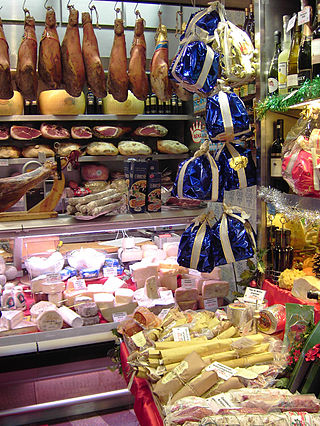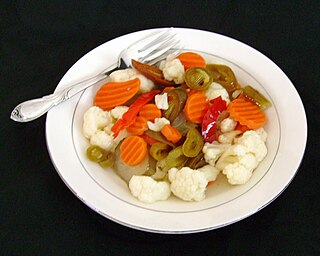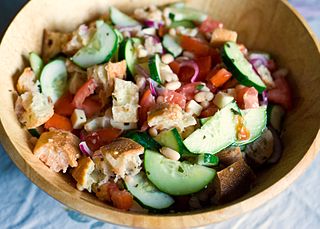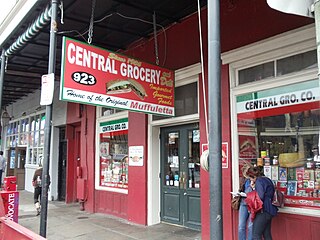
A submarine sandwich, commonly known as a sub, hoagie, hero, Italian, grinder, wedge, or a spuckie, is a type of American cold or hot sandwich made from a cylindrical bread roll split lengthwise and filled with meats, cheeses, vegetables, and condiments.

Traditionally, a delicatessen or deli is a retail establishment that sells a selection of fine, exotic, or foreign prepared foods. Delicatessens originated in Germany during the 18th century and spread to the United States in the mid-19th century. European immigrants to the United States, especially Ashkenazi Jews, popularized the delicatessen in U.S. culture beginning in the late 19th century. Today, many large retail stores like supermarkets have deli sections.
Sandwiches That You Will Like is a 2002 PBS documentary by Rick Sebak of WQED. The unique sandwich offerings of cities across the United States are shown, from those that are often found outside of their city of origin to the virtually unknown.

Central Grocery Co. is a small, old-fashioned Italian-American grocery store with a sandwich counter, located at 923 Decatur Street in the French Quarter of New Orleans, Louisiana. It was founded in 1906 by Salvatore Lupo, a Sicilian immigrant. He operated it until 1946 when he retired and his son-in-law Frank Tusa took over the operation. It is currently owned by Salvador T. Tusa, Salvatore's grandson, and two cousins, Frank Tusa and Larry Tusa. The store was one of many family-owned, neighborhood grocery stores during the early 20th century, when the French Quarter was still predominantly a residential area. Though tourists are more common in Central now, it has retained much of its old-world market feel.

Italian-American cuisine is a style of Italian cuisine adapted throughout the United States. Italian-American food has been shaped throughout history by various waves of immigrants and their descendants, called Italian Americans.

Giardiniera is an Italian relish of pickled vegetables in vinegar or oil.

Panzanella or panmolle is a Tuscan and Umbrian chopped salad of soaked stale bread, onions and tomatoes that is popular in the summer. It often includes cucumbers, sometimes basil and is dressed with olive oil and vinegar.

A tuna fish sandwich, known outside the United States as a tuna salad sandwich or a tuna sandwich, is a sandwich made from canned tuna—usually made into a tuna salad by adding mayonnaise, and sometimes other ingredients such as celery or onion—as well as other common fruits and vegetables used to flavour sandwiches. It is commonly served on sliced bread.

A tramezzino is an Italian sandwich constructed from two slices of soft white bread, with the crusts removed, usually cut in a triangle. Popular fillings include tuna, olive, and prosciutto, but many other fillings can be used.

Leidenheimer Baking Company is a bakery in New Orleans. It was started in 1896 by George Leidenheimer, an immigrant from Deidesheim, Germany. Initially located on Dryades Street, it moved in 1904 to Simon Bolivar Avenue, where it continues in business as the city's largest and best-known maker of po'boy bread, a fiercely competitive niche. Leidenheimer bought out its largest competitor, Reising's Sunrise, in the early 1990s, and still manufactures products under the Reising name. It bought another competitor, Angelo Gendusa, in the 2000s.

The cuisine of New Orleans encompasses common dishes and foods in New Orleans, Louisiana. It is perhaps the most distinctively recognized regional cuisine in the United States. Some of the dishes originated in New Orleans, while others are common and popular in the city and surrounding areas, such as the Mississippi River Delta and southern Louisiana. The cuisine of New Orleans is heavily influenced by Creole cuisine, Cajun cuisine, and soul food. Later on, due to immigration, Italian cuisine and Sicilian cuisine also has some influence on the cuisine of New Orleans. Seafood also plays a prominent part in the cuisine. Dishes invented in New Orleans include po' boy and muffuletta sandwiches, oysters Rockefeller and oysters Bienville, pompano en papillote, and bananas Foster, among others.

Italians have had a presence in the New Orleans area since the explorations of the Europeans. Many Sicilians immigrated to New Orleans in the 19th century, traveling on the Palermo-New Orleans route by ship. The number of Italians who immigrated in the late 19th century greatly exceeded those who had come before the American Civil War. Only New York City has a higher population of Sicilian-Americans and Sicilian immigrants than New Orleans.
Sicilian orthography uses a variant of the Latin alphabet consisting of 23 or more letters to write the Sicilian language.

Breads on Oak is a bakery and café in New Orleans, Louisiana in the United States that specializes in organic ingredients, breads, vegan cuisine, and a café style menu of breakfast and lunch food offerings. There are two locations, the original bakery on Oak Street and a second location on Carondelet Street, which opened in 2020. Upon its opening in 2012, Breads on Oak was the first bakery and café in New Orleans to use only organic ingredients.

Sebastiano's' is a Sicilian delicatessen, bakery, and market in Portland, Oregon's Sellwood-Moreland neighborhood, in the United States. Established in 2020, the business previously operated in the Montavilla neighborhood.

DeLaurenti Food & Wine is an Italian speciality grocery store and delicatessen at Seattle's Pike Place Market, in the U.S. state of Washington.













